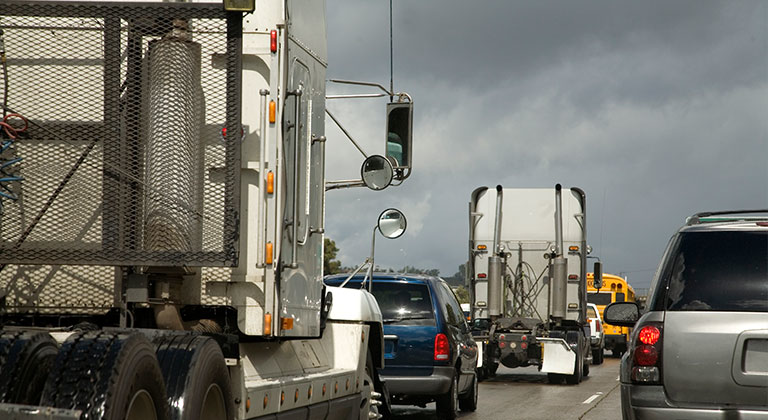Learn defensive driving skills
Tips for making long hours on the road safer for drivers and others
We’ve all been taught the best drivers are defensive drivers. That means searching the road ahead for hazardous or changing driving conditions, preparing for mistakes by other drivers or pedestrians, and checking the sides and rear for passing or approaching vehicles.
But paying attention on the road also means avoiding some common distractions—cell phones and other devices, eating and drinking, smoking, or adjusting radios and other controls.
There’s even more to consider once the truck starts rolling:
Driving
Just moving from a stop—forward, backward, or turning—can create unexpected hazards. Before putting the vehicle in motion, drivers should:
Adjust mirrors
Check for broken mirrors and loose mountings
Make sure horn, back-up warning signal, tail lights, brake lights, and turn signals are all functioning
Walk around and look underneath vehicle for safe clearances
Check that cargo loads are secured
Check blind spots
Begin moving immediately after safety checks
Passing
Safe passing maneuvers require well-developed skills and judgment. Here are some tips:
Make sure there is adequate distance to pass
Check that no one is passing you before you attempt to pass
Watch out for vehicles that may suddenly enter the road from side roads
Stop your pass if the vehicle ahead speeds up
Assume approaching vehicles will not see you
Turning
Recognize the hazards created by turning and follow proper procedures to minimize them—including using turn signals and checking mirrors.
For right turns, drivers should:
Move to the right lane well in advance of the intersection
Wait for other vehicles to clear and then turn slowly
Avoid improper tracking so the vehicle or trailer will not ride up onto the curb or into stationary objects
When turning left:
Watch for drivers who may misinterpret the intended turn
Avoid turning until there is enough time for the rear of vehicle to clear the intersection
Be aware that opposing drivers may not see you
Assume approaching vehicles will not see you
Intersections
Trucks take more time to cross and clear intersections than autos. That’s why drivers should:
Install reflectors and reflective tape
Keep sides of vehicle clean and marker lights operational
Avoid turning until there is enough time for the rear of vehicle to clear the intersection
Lane use and lane changing
Lane use and lane changing accidents primarily involve sideswipes and rear-end collisions. Unnecessary lane changes can increase the potential for a crash and should be kept to a minimum. To avoid accidents, drivers should:
Maintain safe following distances
Use turn signals far in advance of any lane change
Flash brake lights to alert drivers of trouble ahead
Check blind spots before attempting to change lanes
Downgrades
Brake failure is the main reason for losing control on downgrades. To avoid it, drivers should:
Inspect, adjust, and replace brake components
Use a descending gear that requires only light brake pressure—10 psi—to slow speed
Never use the hand lever to apply trailer brakes
Adverse driving conditions
Failure to adjust to adverse conditions, reduced traction, and poor visibility are major causes of accidents. During bad weather, drivers should:
Keep tire chains available
Increase following distances
Get off the road and wait for conditions to improve
These are just some of the tips that can help keep drivers safe on the road. Remember by paying attention to safety, you can minimize risk and possibly reduce insurance costs.
Related resources
A little housekeeping. A lot of safety.
A clean workplace means a safe workplace. Picking up boxes, bags, and other debris reduces the risk of an accident. Read on to learn what else you can do.
Properly securing truck loads for safe transport
The manufacturing is done, now it’s time to send your product off. We have some tips on what to do—and what not to do—when it comes time to load it on a truck.






